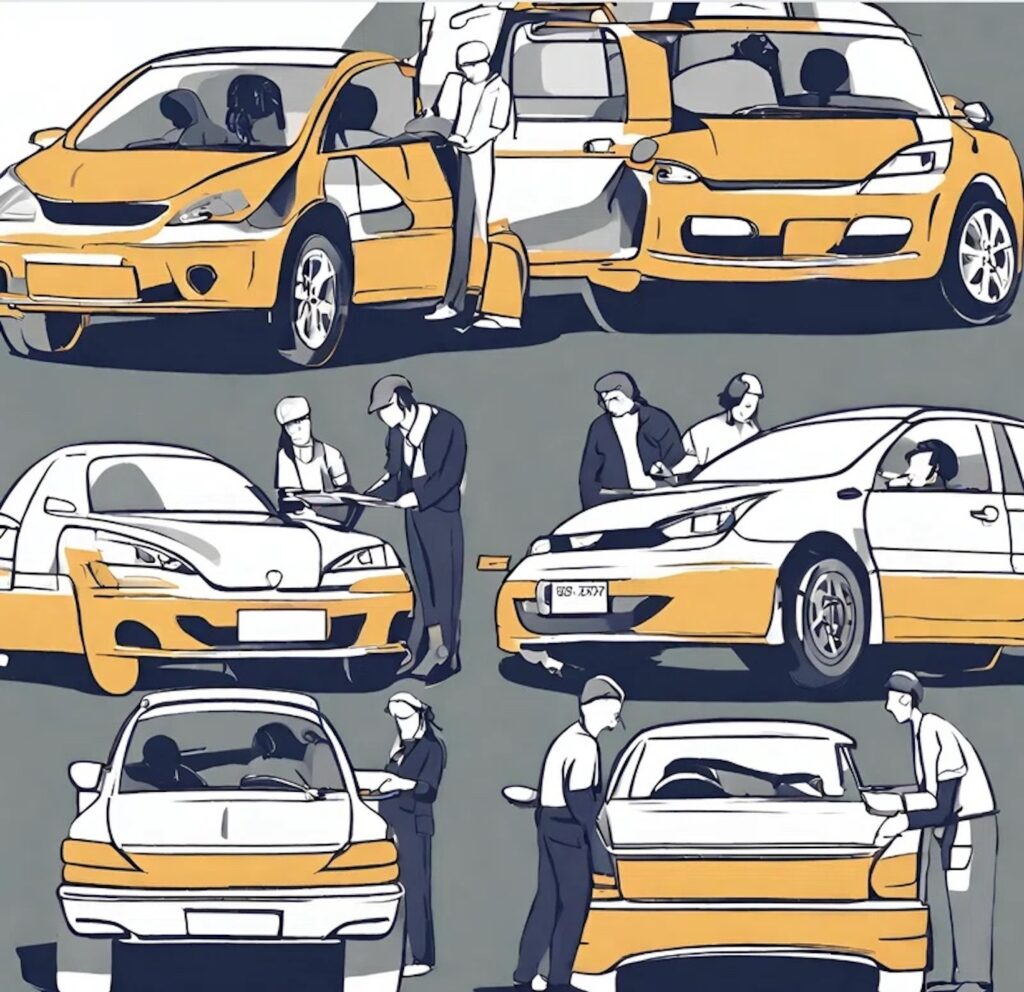初稿では「感じさせる品質=感性品質」について触れましたが、そもそも実際に自動車開発におけるこの評価がどのような位置付けなのかを一度確認しておきたいと思います。元々の考え方は家電やサービスなどの分野でも用いられてきた官能評価などに当たるもので、たとえばエアコン性能などを測る際、風量や温度など数値化できる定量的*なものの他に、ユーザーが感じる「風の当たりが柔らかい」といった定性的*な商品の印象を開発のために指標化するのが目的となっています。
*定量とは「数値化できるもの」 *定性とは「数値化できないもの」を指します。
感性品質の調査手法
この官能評価での調査手法は開発側が定めた印象を問う設問に一定数のユーザーが5〜10段階評価を付けて項目ごとの加重平均を測るものですが、実際の自動車開発で感性品質評価を行なう場合は自社開発車種のベンチマーク(競合車)とする各メーカー車両を集め、定めた品質指標に沿って社内と社外で比較評価し、5段階で採点した平均値(加重平均)を算出するフローが一般的です。
その評価指標は内外装含めて数多くの項目がありその優先度もさまざまですが、日々発売される各社新車を都度社内評価メンバーが集まって実査協議しながら点付けするという比較的工数の掛かるもので、開発に関わる分野〜デザイン、設計、材料、テスト、製造などから集められた社内エキスパートが行なうことが多いようです。
彼らは概ね普段の業務の合間を縫ってその活動を担っていることが多く、その両立にとても骨が折れる事は容易に想像できます。

ただ、そこまでしてもそれを行なうのは、感性品質がクルマの価値を示すひとつの大切な要素になっていることの表れであり、また基本品質のように定量的な判断基準を設定するのがとても難しいためです。
隙間や段差が設定値の交差範囲にできてさえいれば良し悪しの評価ができる基本品質は明確かつ目標値も立てやすい一方、感性品質はそういった定量的判断ができないため、商品を見る人が感じた印象を客観的に評価できる適切な指標を作成して、開発内での各部門のエキスパート評価と一定数の一般ユーザー(既に購入、購入検討中、結局購入せずなどの属性別)のそれぞれがジャッジした評価との相違と近似を測りながら結果を平均化、最適化して検証し、必要とあれば対策します。
ここまですることにより、その商品において客観性を持った必要な感性品質レベルが算定できます。

感性品質調査の位置付け
とても労力のかかるこの評価フローですが、デザインの良し悪し、好き嫌いの判断が過去曖昧だったものが、この手法の導入によって一定のあるべき姿として目標値として明確化・共有化されてきているのは事実です。
従来、量産車開発ではその最終段階で行なう一般ユーザーにモデルを見せて行う評価(クリニック)等によってその製品のデザインが当初の狙いを達成できているか確認するものとして古くから行なわれてきましたが、タイミング的にデザインの終盤で行なわれることが多く、その調査結果も”検証”のためのスタンスが拭えず、クリニックで抽出された課題にも抜本的な対策が取りづらいものでした。
一方で感性品質評価は、開発初期に機密上の理由で社内メンバーのみに限られながらも抽出された課題をできる限り早いタイミングで対策できるという点で優位性があり、その結果内容を開発の後半で行なう一般ユーザー評価(クリニック)と照らし合わせて客観性を保証させていくという手法によって、今や感性評価が開発段階でひとつのフローとして確立されてきていることは注目すべき点です(※発売後に一般ユーザーに行う検証的なクリニックもあります)。
感性品質はただの標準化なのか?
感性品質調査では、同じ意味合いを持つ設問にも各社それぞれのデザインフィロソフィーが投影されているように思います。狙うべき感性品質レベルを測る指標にこそ「そのメーカーらしさ」が滲み出ているところがとても興味深いところで、それぞれの会社が何を大切にすべきかという「核」のようなものが存在しています。
昨今の日本の自動車業界が混沌とする世界情勢やEV動向に直面する中、各メーカーのデザインセクションは今後の狙いをどう定めていくのか。その羅針盤になり得るひとつの考え方に感性品質指標が存在していることを引き続きお伝えしていきたいと思います。
Perceved Quality in Automotive Development
In my first article, I mentioned “quality that makes you feel = perceved quality.” In this article, we will review once again how the evaluation of perceved qualityis actually positioned in automobile development.
Perceved quality survey Methodology
The original idea came from sensory evaluation, which has been used in the fields of home appliances and services. For example, when measuring the performance of an air conditioner, in addition to quantifiable* items such as air volume and temperature, qualitative* product impressions such as “softness of the air” can be used as an indicator for development
*Quantitative means "something that can be quantified.” *Qualitative refers to "things that cannot be quantified.”
In this sensory evaluation survey method, a certain number of users give a rating of 5 to 10 to the impression questions set by the developer, and a weighted average is calculated for each item. In the actual process of perceved quality evaluation in automobile development, vehicles of various manufacturers that are benchmarks (competitor vehicles) for the company’s own developed models are collected, compared and evaluated internally and externally according to the established quality index, and an average value (weighted average) scored in 5 levels is generally calculated.
The evaluation indexes include a large number of items, including interior and exterior, and their priorities vary, but it is a relatively time-consuming process in which in-house evaluation members gather to inspect and discuss each new car released by each company on a daily basis and assign points. In many cases, in-house experts from design, Body Engineering, materials, testing, manufacturing, and other fields related to the development are involved in the process.
It is easy to imagine that it is very difficult for them to manage these activities, as they are often required to take time off from their daily work.

However, the reason we go to such lengths is because it is an indication that perceved quality has become one of the most important elements of a car’s value, and also because it is very difficult to set quantitative criteria (like basic quality).
Basic quality, which can be evaluated as good or bad as long as gaps and steps are within a set value intersection range, is clear and target values are easy to set.
On the other hand, since such quantitative judgment is not possible for perceved quality, it is necessary to create an appropriate index that can objectively evaluate the impression felt by the person viewing the product, and measure the difference and approximation between the expert evaluation of each department in the development process and the evaluation made by a certain number of general users (by attribute, such as already purchased, considering purchase, or not purchased in the end). The results are then averaged, optimized, and verified, and if necessary, countermeasures are taken.
By going this far, the required level of perceved quality can be objectively calculated for the product.

Positioning of Perceved quality Survey
This evaluation flow is very labor-intensive, but it is a fact that the past ambiguity in judging whether a design was good or bad, or whether we liked or disliked it, has been clarified and shared as a ‘target value’ as a ‘certain ideal’ through the introduction of this method.
In the past, mass-production vehicle development has been conducted at the final stage of development to confirm whether the design of the product has achieved its initial goal by showing the model to the general public for evaluation (clinic), etc. However, in many cases, the timing of the clinic is at the end of the design stage, and the results of the survey are not always clear. The results of these surveys often have a “verification” stance, making it difficult to take drastic measures to address the issues identified in the clinics.
On the other hand, perceved quality evaluation has the advantage of being able to address issues identified in the early stages of development at the earliest possible time, even though it is limited to in-house members only for confidentiality reasons, and the results are compared with general user evaluations (clinics) conducted in the latter half of development to ensure objectivity. It is noteworthy that perceved evaluation has now been established as a flow in the development stage. (*Verification clinics are also conducted for general users after the product is launched.)
Are Perceved quality surveys standardized?
In the survey on perceved quality, it seems that each company’s design philosophy is projected onto the questions that have the same meaning. It is very interesting to note that the indicators that measure the level of perceved quality that should be aimed for are the ones that reveal the “uniqueness of the manufacturer,” and there is a kind of “core” of what each company should value.
As the Japanese automotive industry faces the chaotic global situation and EV trends in recent years, how will the styling sections of manufacturers determine their future goals? We would like to continue to report on the existence of the perceved quality Index as a possible compass for the future.

![by Car Styling [カースタイリング]](https://motor-fan.jp/wp-content/uploads/2025/04/carstyling-jp_logo.png)






